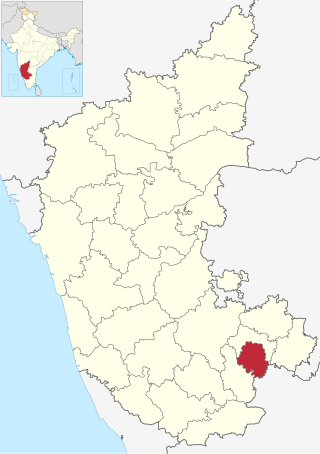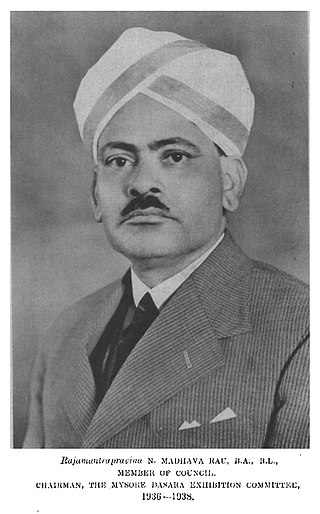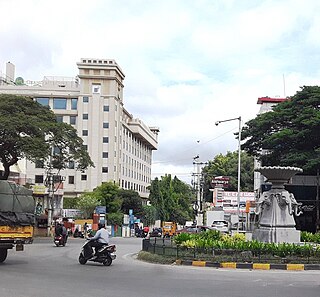Agrahara may refer to places in India:
Agrahara may refer to places in India:
Dasara may refer to:
Gandhari may refer to:
Hemmige is a small village located near Mysore, India. The village was once home to a sizable population but now consists of less than 30 households. On the banks of the river Kaveri, this village is the site of one of the oldest temples of Varadaraja, a form of Vishnu.

Mysore district, officially Mysuru district, is an administrative district located in the southern part of the state of Karnataka, India. It is the administrative headquarters of Mysore division.Chamarajanagar District was carved out of the original larger Mysore District in the year 1998. The district is bounded by Chamrajanagar district to the southeast, Mandya district to the east and northeast, Kerala state to the south, Kodagu district to the west, and Hassan district to the north.

An Agraharam or Agrahara was a grant of land and royal income from it, typically by a king or a noble family in India, for religious purposes, particularly to Brahmins to maintain temples in that land or a pilgrimage site and to sustain their families. Agraharams were also known as Chaturvedimangalams in ancient times. They were also known as ghatoka, and boya. Agraharams were built and maintained by dynasties such as the Pandya, Cholas, Kadambas, Pallavas, Vijayanagara and other deccan dynasties since ancient times.

Krishnarajanagara is a town in Mysore district in the Indian state of Karnataka. It is also the administrative center of Krishnarajanagara Taluk.
Sudharma is the daily newspaper printed in Sanskrit in India. The paper is published from the city of Mysore in the Indian state of Karnataka. Established in 1970, the paper is mainly distributed via mail, a method that its founder resorted to when news vendors refused to stock his paper.

Talagunda is a village in the Shikaripura taluk of Shivamogga district in the state of Karnataka, India. Many inscriptions found here have provided insights into the rise of the Kadamba Dynasty.

Agrahara Belaguli is a village in Karnataka, India. It is situated about 25 km northeast from Channarayapattana in Hassan district. It was a major town before the 14th-century during the Hoysala times. Early inscriptions here date from the 11th and 12th-century. Kesava Dannayaka – a general of king Vira Ballala, added several Hoysala temples dedicated to Shiva and Vishnu here in early 13th-century. He also constructed a water reservoir called Kesavasamudra. This historic water infrastructure is now to the west of the village. The village became an Agrahara who were believed to be following Shatkarmas in the second half of the 13th-century, renamed as Kesavapura. This town was destroyed after the 13th-century. Belaguli is now a small village, and most of the historic temples ruined. Of these, the Betteshvara temple – Kesavesvara temple in inscriptions survives in the most preserved form. This is a twin-temple, with two equal sanctums, one dedicated to Kesava-Vishnu and other to Isvara-Shiva. It has beautifully carved pillars and partly mutilated remains of Shaivism, Vaishnavism, Shaktism and Vedic deity relief panels.
Agrahara is a village in the southern state of Karnataka, India. It is located in the Hunsur taluk of Mysore district in Karnataka.

Agrahara Palya is a village in the southern state of Karnataka, India. It is located in the Bangalore North taluk of Bangalore district.

SirNyapathi Madhava Rau was an Indian civil servant, administrator, and statesman who served as the 23rd dewan of Mysore from 1941 to 1945 and later as a member of the Drafting Committee of the Constituent Assembly which drafted the Indian Constitution.

Mysore betel leaf is a variety of heart shaped betel leaf grown in and around the region of Mysore. It is consumed as a betel quid or as paan, with or without tobacco. A sheaf of betel leaves is traditionally offered as a mark of respect and auspicious beginnings. Areca nut are kept on top of the sheaf of betel leaves and offered to the elders for their blessings and during wedding ceremonies.

Krishnaraja Assembly constituency is one of the 224 constituencies in the Karnataka Legislative Assembly of Karnataka with having all the areas under the zone of Mysore south such as Ashokapuram, Vidyaranyapuram, JP Nagar, Srirampura, Mysore Palace, Agrahara, KR circle, and Vishweranagara. It is also part of Mysore Lok Sabha constituency.

Agrahar may refer to:
Ashokapuram may refer to:
Agrahara Circle, officially known as N. Madhava Rao Circle, is a street circle and a suburb in the southern Indian city of Mysore in Karnataka.

Agrahara is an area of the city of Mysore in the state of Karnataka in India. Famous locations in Agrahara include Mysore Palace as well as several gardens and historic temples. The area is bounded by Albert Victor Road to the North, MG Road to the South, Bengaluru-Nilgiri Road to the East, and Cheluvamba Agrahara Road to the West. The term agrahara or agraharam refers to a grant of land and agricultural income made by royalty to Brahmins in pre-independence South India. Though the Mysuru Agrahara is commonly referred to as a single neighbourhood, it is a composite of multiple adjacent smaller settlements built over time.